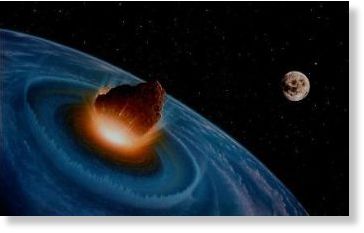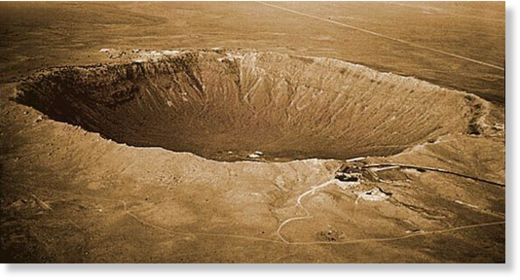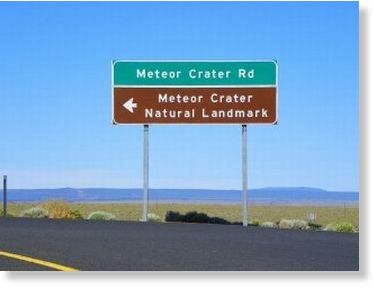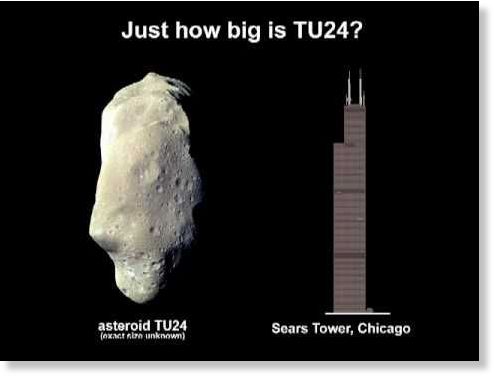
© Andrew C. Steward'Near Earth Object Impact Hazard
"Of our elaborate plans, the end
Of everything that stands, the end
No safety or surprise, the end
I'll never look into your eyes...again"The Earth has been a stage where countless scenes have played out from a script that was written by fate. Every form of life will have its time in the sun, until changing conditions allow new species to reign.
When dinosaurs roamed unchallenged, ancestral mammals were insignificant creatures that scurried about in the shadows, biding their time. Then a meteor impact 65 million years ago brought the curtain down on the age of dinosaurs, and opened the door for mammals to thrive and evolve into beings that could reach out for the stars. Scientists have had to accept the fact that such catastrophic impacts have been a regular occurrence in our history.
In our Human world we have created knowledge of chemistry, biology, history, and art. We have dedicated our lives to solving philosophical challenges and attempted to separate right from wrong. But we have perhaps mislead ourselves into believing that these things have enduring substance that will protect us from the realities of the universe. Another player will one day move onto the horizon of humankind, something so deceptively powerful that we can scarcely believe that in the span of a day, everything that we hold so dear could be gone, to disappear like the Gardens of Babylon under the sands of time.

© Unknown
As you read this, a piece of rock hurtles through the boundless realm of space. Pulled by the gravity of planets and pushed by collisions with other objects, it is one among millions. Only science can save us now, but will we unite to realize the threat, and can we react in time?
It's not a matter of if, but when the next major meteor impact will occur. Approximately once per year, objects 5-10 meters wide enter the upper atmosphere, usually vaporizing there, unleashing the power of the atomic bomb that was dropped on Hiroshima. Within the limited sphere of recorded history there have been indications of much greater power that lurks in the void of space.
The Arizona Meteor Crater is not far from Winslow. It is a mile across and over 550 feet deep. An asteroid traveling approximately 28,000 miles an hour formed this, the world's best preserved meteor crater, about 50,000 years ago. The object that formed it is known as the Canyon Diablo Meteorite, and is estimated to have been 54 yards in diameter. The fact that most of the impactor was vaporized, and very little of the material was buried in the crater, led to an initial conclusion that it was volcanic in origin.
The Tunguska Event is believed to have been caused by the explosion of a meteor or comet fragment 3 to 6 miles in the air near the Middle Tunguska River in Russia in June of 1908.
The mysterious event flattened trees over an area of 1000 square miles. The meteoric origin of the event is supported by eyewitness accounts of a bluish light moving across the sky from east to north.

© Unknown
The shock wave knocked people off their feet hundreds of kilometers away. The blast created no crater, but rather a butterfly-shaped pattern of destruction with a central area where trees were scorched, but remained standing.
This pattern has been verified with subsequent small-scale recreations of an aerial explosion. Also consistent with the meteor explosion theory is the discovery of microscopic spheres in the blast zone containing nickel, iron, and other metals assumed to be of extraterrestrial origin.
Evidence also suggests that Lake Cheko in the Tunguska region was created by a fragment of the incoming meteorite. Interestingly, another theory holds that the Tunguska explosion was the result of an experiment by Nikola Tesla using the Wardenclyffe Tower.
It is also 17 years since fragments of the Shoemaker-Levy 9 comet
smashed into Jupiter, in July 1994, giving astronomers a first-hand look at the devastation that follows such cosmic collisions.
A similar impact event seems to have happened again. On July 19, 2009, an amateur astronomer named Anthony Wesley observed a strange black blob the size of the Earth on the surface of Jupiter. When he alerted NASA professionals, they confirmed that it appears to have been caused by another impact event.

© UnknownApollo asteroid 2007 TU24
The Apollo asteroid 2007 TU24 approached Earth on January 29, 2008 with a distance of 1.4 LD (lunar distance), or 450,000 km, with an estimated size between 300-600 meters. It may be the closest asteroid to pass Earth until 2027. A program known as Spaceguard is underway in Europe and the United States to track NEOs, and NASA has been mandated by congress to catalog all NEOs at least 1 kilometer wide.
Spaceguard encompasses several affiliated efforts. Calculations indicate an incoming object over 1 kilometer in diameter would likely cause the extinction of the human race. Unfortunately, the NASA goal is a 90% detection rate, which leaves future catastrophic impacts a distinct possibility.
Over 7000 NEOs have been detected as of May, 2010. Of those, 1,125 are classified as Potentially Hazardous Asteroids, and hundreds are at least 1 kilometer in size. 84 near-Earth comets have also been discovered. Collision avoidance strategies are varied depending on the type and make-up of particular NEOs.
Some NEOs consist of loosely associated groups of debris, and as such deflection is difficult, but not impossible. Strategies include deflection or fragmentation, various energy sources such as nuclear or electromagnetic, and different approaches such as interception or rendezvous.
In general, NEOs may be fragmented or delayed to avoid an Earth-bound trajectory, or nudged slightly into a different path.
The words of U.S. Representative George E. Brown Jr. (D-CA) are well worth repeating. "If some day in the future we discover well in advance that an asteroid that is big enough to cause a mass extinction is going to hit the Earth, and then we alter the course of that asteroid so that it does not hit us, it will be one of the most important accomplishments in all of human history."
Even if something was detected that was an urgent threat, there is no effective plan that could respond in an immediate time frame. Theories abound as to what might work, but what is needed is a tested plan that could be launched within hours.
We need something on the launch pad right now. Nothing less would save humankind from potential extinction. While we fuss about smartphone apps and the latest political gaffs, the clock of destiny is ticking. Let me repeat, it's not if, but WHEN.
Sources:http://en.wikipedia.org/wiki/Meteor_Crater
http://www.meteorcrater.com/
http://en.wikipedia.org/wiki/Tunguska_event
http://jupiter.samba.org/jupiter-impact.html
http://www.timesonline.co.uk/tol/news/science/article6721504.ece
http://www.jpl.nasa.gov/news/news.cfm?release=2009-112
http://en.wikipedia.org/wiki/Asteroid_deflection_strategies
http://en.wikipedia.org/wiki/2007_TU24
http://impact.arc.nasa.gov/news_detail.cfm?ID=39
http://en.wikipedia.org/wiki/Near-Earth_object
http://neo.jpl.nasa.gov/
http://www.sing365.com/music/lyric.nsf/the-end-lyrics-the-doors/84f23926d0b3b1414825689700344491J. D. Adams was born in Salem, Oregon, a descendant of Oregon Trail pioneer William Lysander Adams. As a wilderness explorer, photographer, and writer, he sustains a kinship with the spirit of the Oregon country. JD inhabits Oregon's Silicon Forest as an electronics professional with degrees in Electronics Engineering Technology and Microelectronics.
He maintains a Web presence with a signature presentation in genres including travel, history, and technology.
You can write to Jim Adams at this email address: j1mcm0s@earthlink.net
Also, visit Jim's Website
check this site for current info on near-earth objects, sunspots, aurorae etc.
[Link]
And by the way, Salem News, only a couple of days ago an 8-metre asteroid passed inside the moons orbit. This happens several times a year. Last year one zipped past only 25000 miles away.